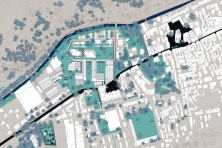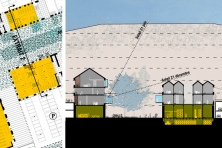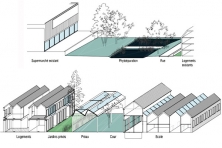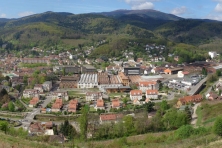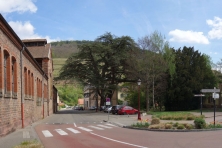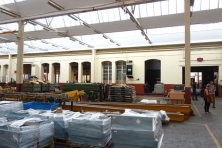Manufacture de terroirs
Guebwiller (FR) - Special Mention
TEAM DATA
Team Representative: Morvan Rabin (FR) – geographer
Associate: Sylvie Florette (FR) - urbanist architect
See the complete listing of portraits here
See the site page here

M. Rabin & S. Florette
INTERVIEW
Click on the images to enlarge
1. How did you form the team for the competition?
We know each other for several years. The constitution of our team answers the rules of the competition, which require an architect among the partners.
2. How do you define the main issue of your project, and how did you answer on this session main topic: the place of productive activities within the city?
We used on the re-interpretation of Patrick Geddes's formula: "it takes the whole region to make the city". The main question of the project, thus, explores to what extent all the productions of a region can generate a productive city. Between the plain of Alsace and the Vosges mountains, in the crossing of Florival and the wine trail, Guebwiller can indeed mobilize its ‘terroirs’ to reconvert its brownfields sites. Two movements are for it necessities.
The first one involves rethinking the relationship between the territory and economy, in passing of a territory support of the Economy in a generative territory of productions.
The second consists in spreading the logic of the existing ‘terroirs’ (wines of Alsace, Munster cheese, etc.) to a panel of less exceptional activities and not necessarily related to food. The North of Guebwiller can become a "factory of terroirs", bridgehead of local craft sectors, of which some are re-revitalizing (wood of Vosges, cereal of the plain of Alsace, etc.) when others remain to invent (recycling of building materials; construction in hiding and sands reused: adobe, rammed earth, local concrete, bricks...). A first sketch of potential sectors was proposed, that a real project will have to specify and to structure.
3. How did this issue and the questions raised by the site mutation meet?
The activities of ’terroirs’ are localized according to their capacity to coexist with housing and equipment enable to activate ground floors because they often present a double vocation of production and sale. So, they offer a complement to the programs (tertiary-commercial) already in progress near the place of the project while enabling to reuse at the most the existing buildings. Their presence joins in a more global logic of structuring this Northern part of the city. The place of the project, indeed, constitutes the main part of a network of public places, which reconnect the main elements of the geography of Guebwiller (hillsides, valley, river) and offer to all citizens a panorama towards the close and distant landscape.
4. Have you treated this issue previously? What were the reference projects that inspired yours?
We had already handled this problem of the productive city within the framework of various work experiences, both in town planning as in agriculture. The references of the project are at first three quotations guiding the proposals: - "It takes the whole region to make the city" (Patrick Geddes) - "Destroy nothing before being sure to propose better" (Roland Simounet) - "Do not produce waste (...) Intercept and store the energy" (David Holmgren). Other projects or approaches were mobilized, in particular that of Fives Cail Babcock designed by Djamel Klouche/the AUC, and the researches and the actions of recycling/re-use of Bellastock in France or Rotor in Belgium.
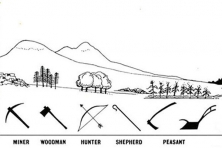
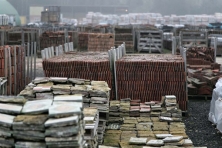
At this particular stage of the process that is the competition, we tried to work the feasibility of our proposals. Indeed, we think that while integrating most upstream possibility, the constraints, which we can make so that the development of the project is not an undressing of the initial ideas, even if it is a dead end, but an enrichment of the intentions formulated during the competition. It is a question of installing the " feasibility as manifesto " (Bernardo Secchi & Paola Vigano). This approach seems to us particularly adapted to Guebwiller because the place of project is characterized by the interweaving of buildings among which the size, the heights and the structures present a very big variety. Certain elements of program (a 10 classes nursery school, a multi-purpose hall which can welcome concerts, boiler room biomass) imply technical constraints and call up to clear choices in terms of localization. Move a program in this vast built group can have chain reactions. The project is thus the initial stage of a movement similar to a “plate tectonics” which will continue during the next steps of the process.
6. Is it the first time you have been awarded a prize at Europan? How could this help you in your professional career?
It is not the first time that we are selected as winning team, we were selected also for Europan 12 (in Fosses, France). We hope that the project will continue and thus will generate for us new practical and theoretical reflections.
